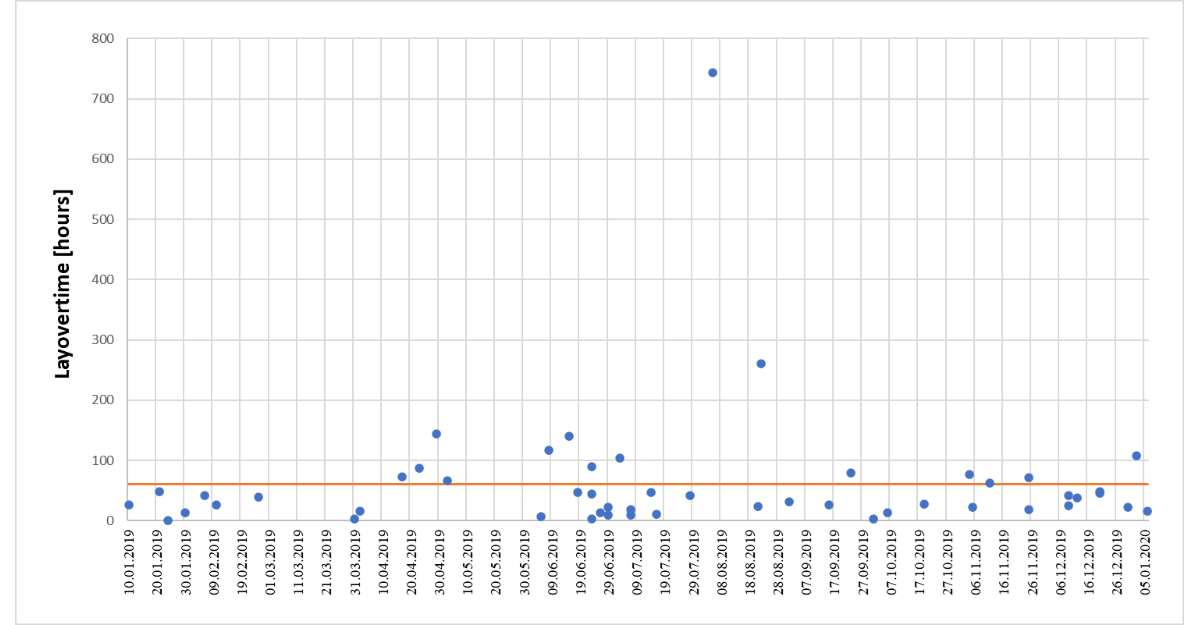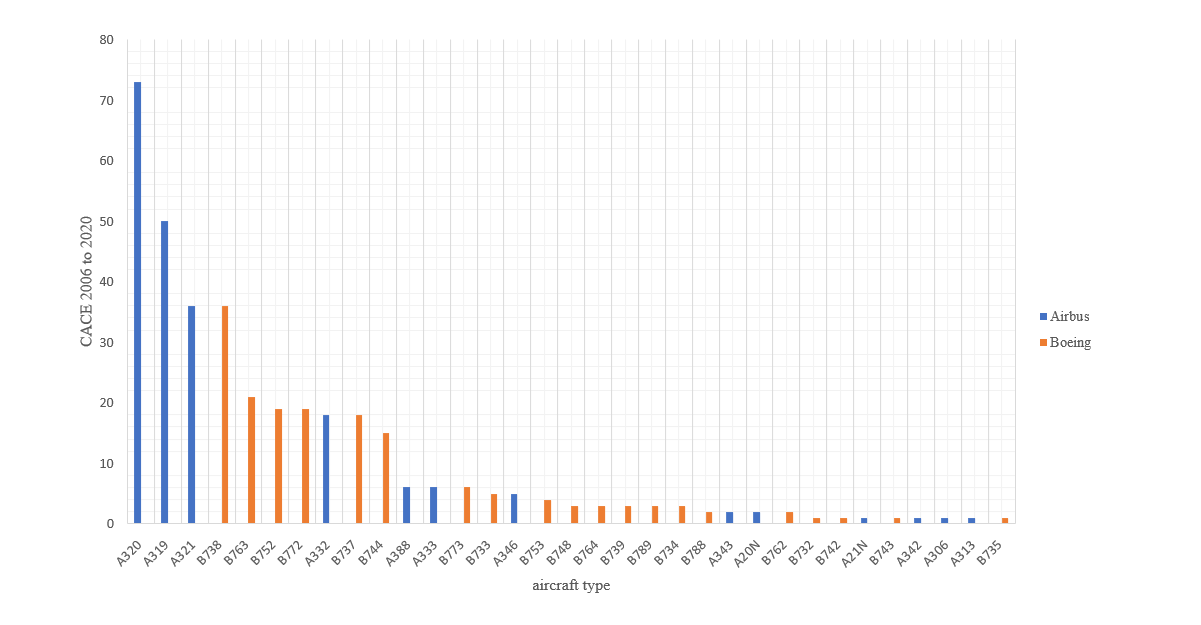

 |
 |
Abstract
Analysis of the Layover Times of Passenger Aircraft after Fume Events Using Flight Tracking
Purpose – The aim of this study is to compile a list of current fume events, to identify the corresponding flights with online flight tracking services, to record the duration of any subsequent layover time and to compare it with the cleaning instructions. Methodology – The online service "The Aviation Herald" was searched. "FlightRadar24" was used for flight tracking. Regarding layovers, only events of one year (2019) were considered. A statistic was created in the form of a pivot table in Excel and evaluated according to various aspects. --- Findings – 425 events were found between 2006 and early 2020, including 51 in 2019. British Airways and Lufthansa were the most affected airlines in absolute terms. 86.7% of all CACE concerns Airbus and Boeing aircraft. It is striking that Airbus A320 Family aircraft are affected much more often than those of Boeing's B737 Family. The ratio here is 2.42. The average layover time after a CACE is 61 hours with a high standard deviation. The minimum layover time is zero (next flight departs as scheduled). The longest layover time was 743 hours (one month). --- Research Limitations – The online service "The Aviation Herald" does not claim to report completely about accidents and incidents. This is especially true for comparatively frequent fume events. Furthermore, the editor himself advises not to take his limited data for a statistic about fume events. Nevertheless, this work makes use of data from "The Aviation Herald" because better data was not openly available. --- Social Implications – Crew members have occasionally expressed the suspicion that airlines are too quick to return aircraft affected by fume events to flight operations, thereby negligently exposing crews and passengers to a health hazard. An attempt is made to objectify this discussion.
| Download full text: |
 TextAyan.pdf
Size:
4.9M TextAyan.pdf
Size:
4.9M |
| Date: | 2020-01-15 |
| Type of work: | Projekt |
| Advisor / Examiner: | Dieter Scholz |
| Published by: | Aircraft Design and Systems Group (AERO), Department of Automotive and Aeronautical Engineering, Hamburg University of Applied Sciences |
This work is part of: |
Digital Library - Projects & Theses - Prof. Dr. Scholz ---
http://library.ProfScholz.de
 |
| PERSISTENT IDENTIFIER: | |
| URN: | https://nbn-resolving.org/urn:nbn:de:gbv:18302-aero2020-01-15.016 (to reach this page) |
| DOI: | https://doi.org/10.15488/19105 |
| ARK: | https://n2t.net/ark:/13960/s2g89prtwdd |
| Associated research data: | https://doi.org/10.7910/DVN/SME6VL (Program) |
| URLs registered with URN: | Show all links associated with this text! |
| CATALOG ENTRY: | |
| DNB: | Check inclusion of this title in German National Library! |
| WorldCat: | Check inclusion of this title in WorldCat! |
| DataCite: | Check inclusion of this title in DataCite! |
| Google Scholar: | Check inclusion of this title in Google Scholar! |
| OpenAIRE: | Check inclusion of this title in OpenAIRE! |
| Semantic Scholar: | Check inclusion of this title in Semantic Scholar! |
| BASE: | Check inclusion of this title in BASE! |
| CORE: | Check inclusion of this title in CORE! |
| Google: | Check inclusion of this title in Google! |
| Keywords, German (GND): | Luftfahrt, Luftfahrzeug, Passagierflugzeug, Flugzeugkabine |
| Keywords, English (LCSH): | Aeronautics, Airplanes, Air--Pollution, Aircraft cabins |
| Keywords, free: | Luftverschmutzung, Flugbetrieb, Flugtriebwerk, Instandhaltung, Liegezeit, Tabellenkalkulation, Wartung, Wartungsdauer, smoke, air conditioning, spreadsheet, fume, emergency, cabin air, contamination, event, CACE |
| DDC: | 629.13, 629.133340423, 629.13445, 363.7392 |
| RVK: | ZO 7215 |
© This work is protected by copyright
The work is licensed under a Creative Commons Attribution-NonCommercial-ShareAlike 4.0 International License
CC BY-NC-SA
https://creativecommons.org/licenses/by-nc-sa/4.0

Any further request may be directed to:
Prof. Dr.-Ing. Dieter Scholz, MSME
E-Mail see: http://www.ProfScholz.de
VISIBILITY: (more)
Quote this text:
| ISO 690: AYAN, Taner, 2020. Analyse der Liegezeiten von Passagierflugzeugen nach Fume Events mittels Flugverfolgung. Projekt. Hamburg University of Applied Sciences, Aircraft Design and Systems Group (AERO). Available from: https://nbn-resolving.org/urn:nbn:de:gbv:18302-aero2020-01-15.016 [viewed YYYY-MM-DD]. |
Major results / graphical abstract:

Anzahl der CACE von Aviation Herald in 2019, die auch auf Flightradar24 beobachtet werden konnten. Liegezeiten von Null über 11 Tage bis zu 31 Tagen. Durchschnittliche Liegezeit: 61 Stunden.

Anzahl der CACE von Aviation Herald 2006 bis 2020 nach Flugzeugtyp.

 Prof. Dr. Scholz
Prof. Dr. Scholz
 Aircraft Design and Systems Group (AERO)
Aircraft Design and Systems Group (AERO)
 Aeronautical Engineering
Aeronautical Engineering
 Department of Automotive and Aeronautical Engineering
Department of Automotive and Aeronautical Engineering
 Faculty of Engineering and Computer Science
Faculty of Engineering and Computer Science
 Hamburg University of Applied Sciences
Hamburg University of Applied Sciences